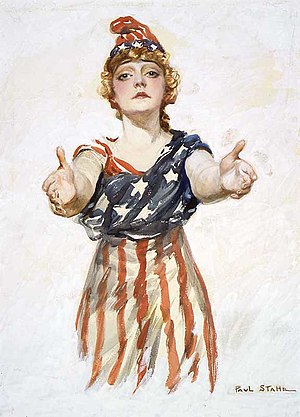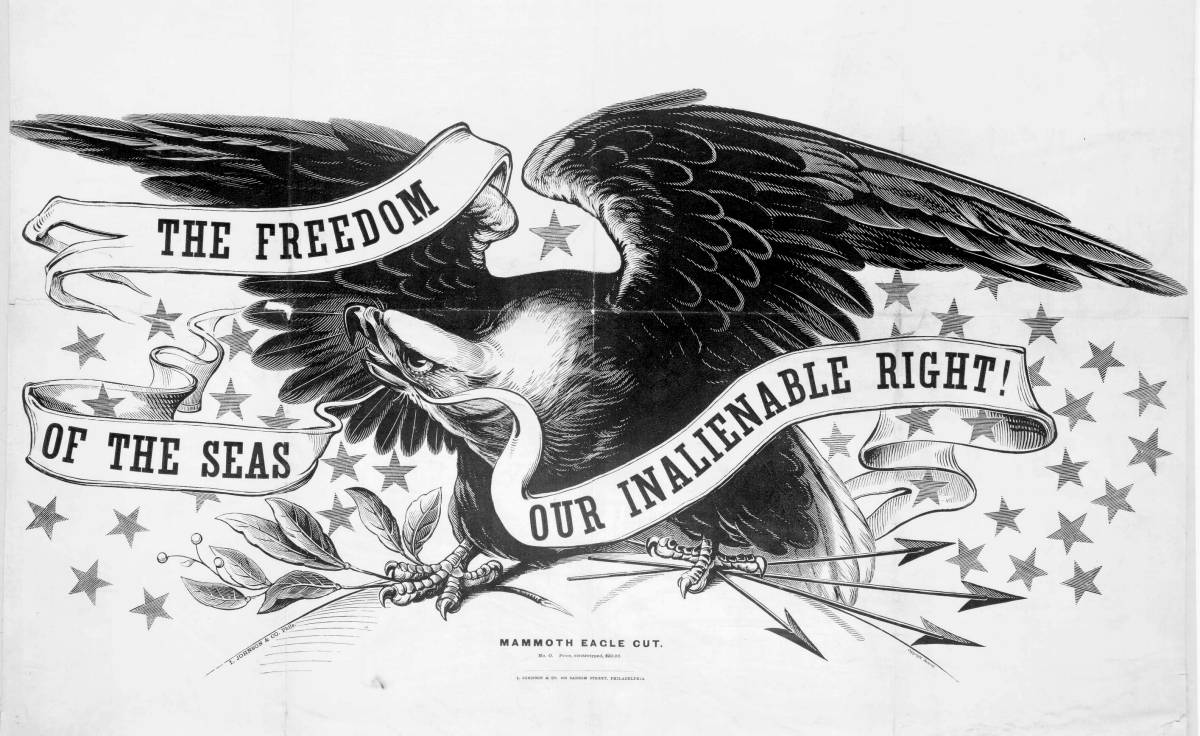
*Star Spangled Banner PowerPoint

* American Patriotic Symbols PowerPoint
American Patriotism: The Symbols that Bind Us U.S. History, Secondary Subject Grade Levels (8 and 11) by B. Anguiano, Laguna Creek High School
There are several lesson components connected to the Star Spangled Banner presented here, which can be used in isolation or in connection with one another based on time constrains and teacher objectives.
Goals and Objectives
Students will:
- Understand the significance of The War of 1812 in creating nationalism
- Examine the American and British perspective of the War of 1812
- Identify and understand symbolism in political cartoons
- Identify the meaning of early American patriotic symbols
- Analyze the lyrics of the Star Spangled Banner and summarize the meaning of the lyrics
- Create their own political cartoon on The War of 1812
- Students will add a verse to the Star Spangled Banner at the end of the school year once they have learned all content, their verse will be their interpretation based on what they learned about American History
Description
Students will learn about the context in which the Star Spangled Banner was created as well as the function it came to serve which result in it becoming the national anthem. Students will also learn about the British and American perspective of The War of 1812. They will learn about patriotic symbols in the early American republic and how the Star Spangled Banner became a patriotic symbol over time. Additionally, students will create their own political cartoon on The War of 1812.
Materials Needed
Lesson Day 1: Lesson Star Spangled Banner PowerPoint, projector, computer, speakers, access to the Internet, background readings (for the teacher), Star Spangled Banner lyrics

Lesson Day 2: British View Article, War of 1812 Point of View Comparison Sheet , American Patriotic Symbols PowerPoint, projector, computer, Elements of Political Cartoons, War of 1812 Cause and Effect & Political Cartoon Assignment
Lesson Day 1: Analysis of Mary Pickersgill image and discussion; direct instruction on the War of 1812 and the Star Spangled Banner; viewing of War of 1812 clip and 2014 version of Star Spangled Banner; written response Star Spangled Banner 2014 version and discussion; analysis of Star Spangled Banner lyrics through Marking the Text and summary; written analysis of tone of lyrics and the role of the SBB in creating nationalism.
Lesson Day 2: Examine War of 1812 perspective; Direct instruction on patriotic symbols; instruction on elements of political cartoons; examine causes & effects of The War of 1812; Create War of 1812 political cartoon
Resources
Web Resources for Patriotic Symbols:
Library of Congress: “WITH PEACE AND FREEDOM BLEST!” Woman as Symbol in America, 1590-1800 http://memory.loc.gov/ammem/awhhtml/aw05e/aw05e.html
Patriotic Symbols
Source: http://www.brownielocks.com/patrioticsymbols.html
Liberty Cap
http://www.aoc.gov/blog/liberty-cap-art-us-capitol
Great Seal
http://www.greatseal.com/
Columbia as a National Symbol
http://www.learner.org/amerpass/unit04/context_activ-5.html
Web Resources for the War of 1812
Smithsonian: The Star-Spangled Banner: The Flag That Inspired the National Anthem
http://amhistory.si.edu/starspangledbanner/
National Park Service: Fort Mc Henry
http://www.nps.gov/fomc/historyculture/francis-scott-key.htm
The Growth of American Nationalism
http://www.digitalhistory.uh.edu/disp_textbook.cfm?smtID=2&psid=3524
The War of 1812: American Independence Confirmed
http://www.nps.gov/revwar/unfinished_revolution/war_of_1812.html
The War of 1812
http://www.pbs.org/wned/war-of-1812/essays/american-perspective/
Star Spangled Banner: National Historical Trail
http://starspangledtrail.net/life-during-wartime/women/mary-pickersgill/
Video Resources:
Francis Scott Key and the Defense of Fort McHenry
http://www.youtube.com/watch?v=05-sVK1SKno
War of 1812 PBS
http://video.pbs.org/video/2089393539/
Standards
California Content Standards:
11.1 Students analyze the significant events in the founding of the nation and its attempts to realize the philosophy of government described in the Declaration of Independence.
- Describe the Enlightenment and the rise of democratic ideas as the context in which the nation was founded.
- Analyze the ideological origins of the American Revolution, the Founding Fathers’ philosophy of divinely bestowed unalienable natural rights, the debates on the drafting and ratification of the Constitution, and the addition of the Bill of Rights.
- Examine the effects of the Civil War and Reconstruction and of the industrial revolution, including demographic shifts and the emergence in the late nineteenth century of the United States as a world power.
Common Core Standards:
Key Ideas and Details:
CCSS.ELA-Literacy.RH.11-12.1
Cite specific textual evidence to support analysis of primary and secondary sources, connecting insights gained from specific details to an understanding of the text as a whole.
CCSS.ELA-Literacy.RH.11-12.2
Determine the central ideas or information of a primary or secondary source; provide an accurate summary that makes clear the relationships among the key details and ideas.
CCSS.ELA-Literacy.RH.11-12.9
Integrate information from diverse sources, both primary and secondary, into a coherent understanding of an idea or event, noting discrepancies among sources.
Historical & Social Science Analysis Skills:
Historical Research, Evidence, and Point of View
1. Students identify bias and prejudice in historical interpretations.
Historical Interpretation
1. Students show the connections, causal and otherwise, between particular historical events and larger social, economic, and political trends and developments.
2. Students interpret past events and issues within the context in which an event unfolded rather than solely in terms of present-day norms and values.
About Banner Moments Made available as part of the 2014 Banner Moments K-12 Institute—a project of the American Music Institute of the University of Michigan and the Star Spangled Music Foundation, sponsored by the National Endowment for the Humanities







